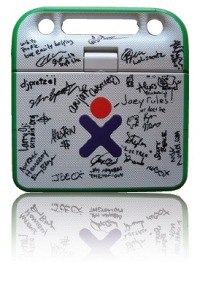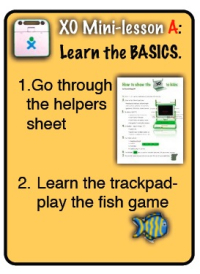This reflection is meant to give an overview of one teacher's experiences with using the XO with students in a real life classroom. Largely on our own, we developed an implementation guide for other teachers to follow, as well as some lesson plans for using the XO not just to assist but to transform learning.
Although based close to a major capital city, & thus not an exact match for what classrooms in third-world & remote communities might be like, our XO class is from a lower-socio economic area with a high proportion of indigenous students, in a demountable classroom with limited technology infrastructure.
First impressions (after one week):
Firstly, as the only designed-for-kids-first device of its kind, its a wonderful wonderful machine. Unlike some organisations whose rhetoric uses all the right buzz words but fails when it comes to living up to them, the XO device really does encourage creating, sharing and connecting just by its very design.
I've only had limited time with two XOs in connected mode so far, but they are so easy to hook up via their built-in mesh networking that almost every activity can be shared between multiple students. This includes co-writing or drawing, or even controlling each others camera, or using the sonar sound activity to measure distance between machines. It really is the learning theory of connectivism personified in a device.
Even the Sugar OS that they run has an interface of brilliant simplicity, with every activity running full screen and auto-saving, while a 'journal' of every activity they have done is accessible with just one button push. I'm looking forward to using them outside regularly thanks to the special LCD screen they have that allows full readability in sunlight.
Further impressions (after six weeks):
Although limited to 12 XOs in a class of 27, I have seen the potential of the XO to transform learning first hand. Students (although not all) take to the machines and learn them very quickly, or are at least prepared to help each other, a great development that makes it easier for the teacher if you're willing to give up some feeling of control in this area. The mesh networking/sharing means that every activity has the potential for extension built-in, and students themselves are often coming up with innovative and new ways to use the XO for their learning.
The XO itself is in need of an upgrade and does struggle at times and suffer from known faults like the trackpad skipping or freezing up, and some activities refusing to close or hanging, requiring a restart. We also sometimes had problems connecting more than two machines at a time for sharing, not sure why. Battery life proved shorter than expected, so dimming of the screen/ sleep mode do need to be aggressively used. Our 'uptime' overall was probably 90% for each machine though, and when the previous amount of technology in a class is 3 old PC's, just having such student-friendly, adaptable and capable machines has proven a huge step forward.
Our implementation program of training a small group of 'XO experts' who then manage the laptops and train the other students has worked brilliantly. This lightens teacher workload while also empowering the students who are more than capable. The lesson plans we have developed have also worked well.
Even further impressions (after 12 weeks):
In this phase we have now had access to 27 XO's (a full class set) which has enabled us to test out their full potential. We have also been able to source enough extra school funds to get some XO-specific furniture like small tables and floor cushions as having laptops enables the kids to learn anywhere in the room, not just in the traditional rows of desks.
Our experience with the XO's has improved greatly with some help from Rangan at OLPC Australia who supplied info like how to reset the trackpad when it freezes, as well as a list of activities ordered by how many laptops can share a particular activity at any one time.
The overall student impression is interesting - they still see them as fun machines, not as work devices - and this is a good thing in that they are working and learning without even realising it. Our XO experts have also been taking on further responsibility now by training students from other classes so the benefits of the laptops can extend across the school.
We are at the stage now where its possible to begin planning a full personalised learning phase - where the XO's enable students to begin taking full responsibility for their learning simply because they have access to so much information and resources.
Jonathan Nalder writes uLearning Blog as a teacher in Australia



